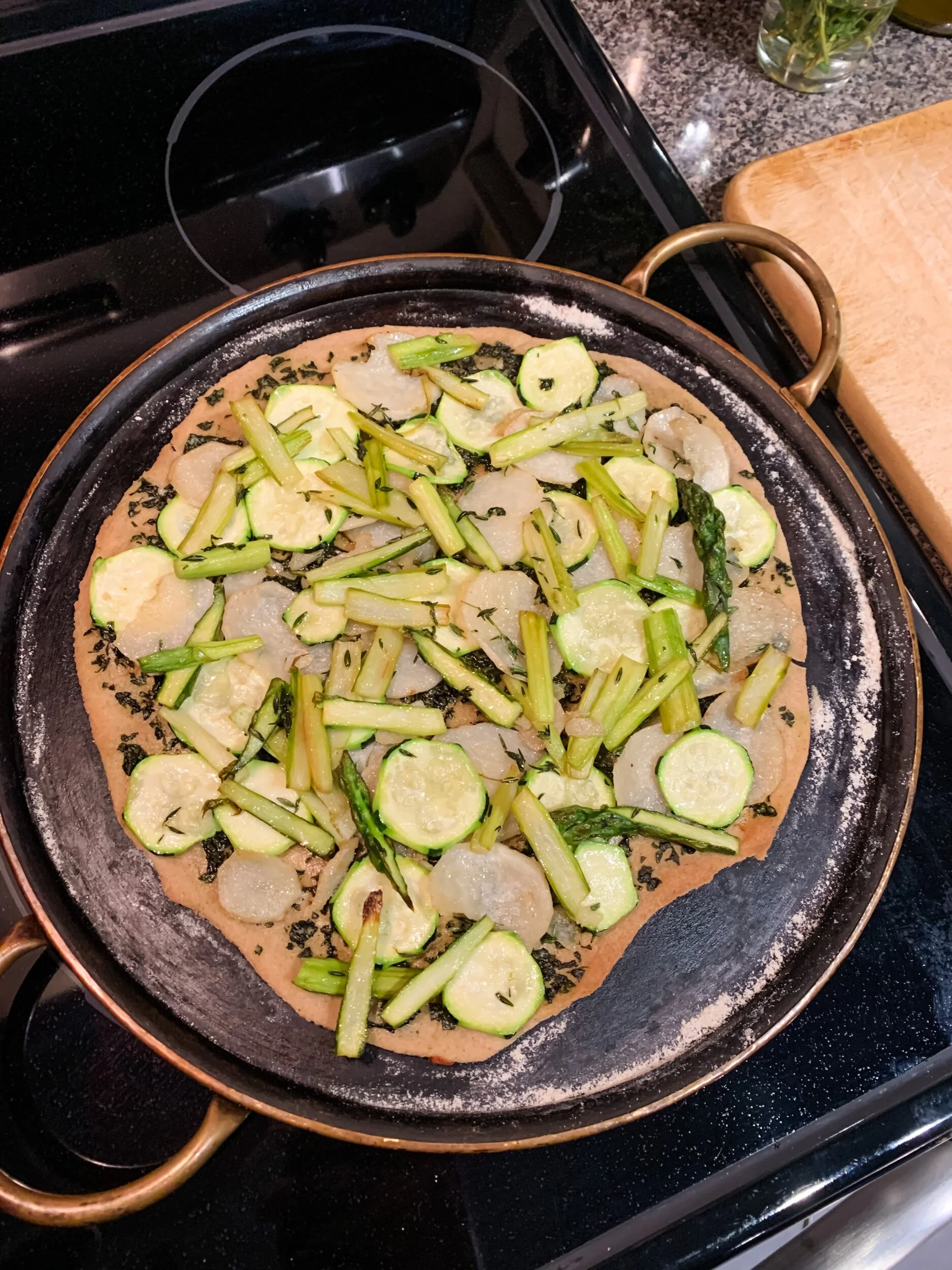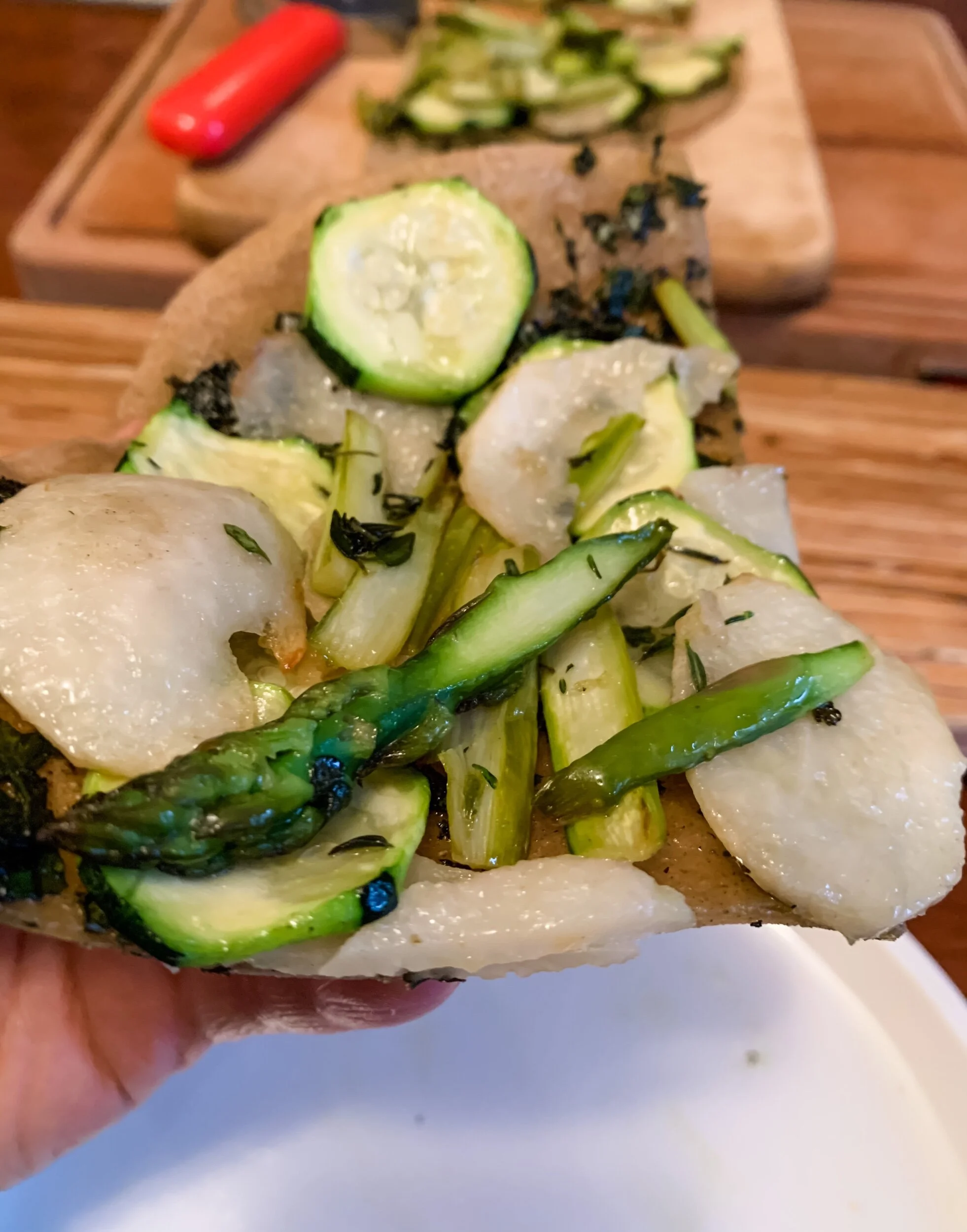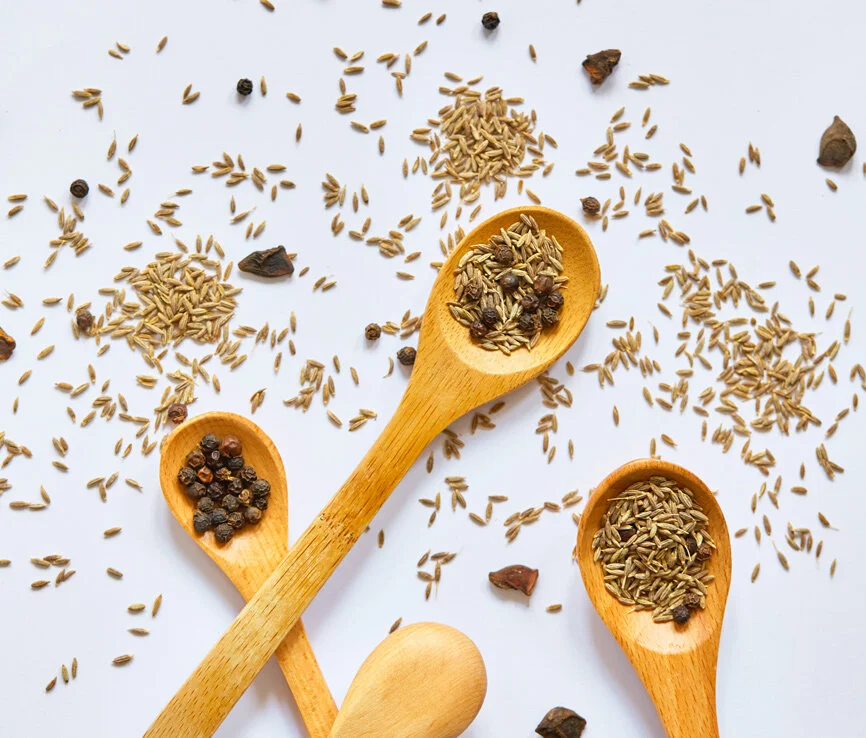Chapati Pizza
WELCOME TO MY BLOG! I’M EVANGELINE. I AM AN RMT AND HOLISTIC HEALTH COACH. I STARTED MY BLOG DURING COVID TO STAY CONNECTED TO MY CLIENTS AND SHARE MY LOVE OF COOKING HEALTHY, AYURVEDIC MEALS.
AYURVEDIC COOKING TAKES A BALANCED, HEALING APPROACH FOR YOUR DAILY COOKING NEEDS. YOU WILL FIND SIMPLE, EASY TO MAKE NOURISHING MEALS I HAVE MADE FOR MY FAMILY, WITH A DOSE OF AYURVEDA & YOGA WISDOM.
I was looking to come up with a fun dish we could all have as a family during my spring detox this year. Something we could all enjoy, but make to suit our own taste, and of course, pizza came to mind. Ideally, especially during a detox, you would want to eat food that is fresh, easy to digest, balanced and nourishing. This pizza recipe has all that!
One step in the direction of detox is avoiding fast food. Check out my recent post on detox- the what, when and why, and safety. For example, cutting out take-out food, canned and frozen, food that lack prana, life energy. These foods also tend to have too much salt, preservatives and trans-fats. Also avoid white sugar, alcohol and bread with yeast. Ideally you would replace all this with fresh, homemade, balanced nourishing meals. A safe and effective detox does not involve depravation of any macronutrient or lack variety or taste. In the spring cleanse I do, nourishing your body with fresh home made food cooked in spices ghee or olive oil is the way to go. This year I am doing it with a group! Check it out here. In fact, nourishment is a must for a safe, proper detox. Toxins naturally come out through our elimination channels, and day in day out we would want to replenish with good food. So it’s the same when doing spring or fall detox, which is correct time of year to cleanse the body of impurities, you must feed, replenish and rejuvenate your body with nutrients to make energy, neurotransmitters, hormones, etc. to build healthy tissues, not deprive yourself. A detox done with this in mind is nourishing for body and mind, and uplifts your spirit, characteristic of a season of renewal and revitalization.
This was my first time making chapati pizza with eddo/taro, and I will definitely add it again. It a was simply delicious. The thyme and basil brought the familiar pizza taste many of us love and a thin pizza crust is favoured by all in the house. In our household we make chapati regularly- simple really, just flour and water to make the dough. Getting back to toppings, yes eddo and taro are not common toppings. I grew up eating these and other more “exotic” vegetables and I have noticed they are making their appearance in non-ethnic grocery stores. Eddos are small round root vegetables with little brown hairs, and taro is a brown, waxy, tubular and bigger. Both have the same binding quality. Like all vegetable binders, eddo and taro have a slimy quality. Don’t let that deter you- it works in this pizza with the basil pesto, asparagus and zucchini! My 7 year old liked it when he took a bite of mine.
Thin pizza crusts, like this one, is satisfying because of the whole grain flour, and any tummy appreciates a break from yeasted bread. I used 50/50 sorghum and einkorn flours for this chapati batch. For gluten-free you can substitute quinoa flour or buckwheat for the einkorn flour. I use these flours and amaranth flour for making pancakes too. I’m looking forward to making this pizza again and I suspect we will make this version throughout the year. You really can’t go wrong with pizza!
What Makes this Pizza Detoxifying?
Spices- helps digestion of food and absorption of nutrients + a host of other health benefits
No yeast in dough- yeast creates toxins in the gut
No salt or minimal. I use soma salt, a white Himalayan salt high in minerals. Cutting down on salt aids in the detoxification process.
Taro- binds toxins helping eliminate them
Coriander- ushers out toxins through the urinary channels
Basil- opens up channels
Asparagus- cleans the kidneys
Zucchini- easy to digest soft squash; a cooling vegetable that pacifies heat in the liver, which has a tendency to overheat because it has five digestive “flames”.
Whole grain flour- nourishing
Chapati Pizza Recipe
Yield: 1 x 12” pizza
Prep Time: 20 minutes
Cook Time: 15 minutes
Ingredients
1 ¼ cups flour- 50/50 einkorn or durum/sorghum + ½ cup spring water room temperature
1 cup basil leaves, not packed too tight + 1/3 cup cashews + 1/4 cup olive oil + 1 tsp ground coriander + ¼ tsp Himalayan soma salt + 1 thai green chili chopped (optional) for pesto sauce
2 tsps ghee or olive oil + another 1 tsp to brush rolled out chapati with
A few sprigs of thyme or rosemary leaves
1 small taro/eddo cut in rounds
6 asparagus spears cut in pieces
1 medium zucchini cut ½-inch rounds
Options with Toppings
½ - 1 cup fresh paneer, crumbled on top when it comes out of the oven- for more protein at lunch time.
Sprinkle toasted Spice Mix (recipe below) on the rolled out dough or when pizza is done, or mix in ½ - 1 tsp ground ajwain or kalunji into the dough preparation.
Ayurvedic Profile of Spices in the Chapati Pizza Recipe
Fennel - supports digestion; cooling quality
Coriander - ushers heavy metals and toxins to kidneys for elimination; cooling quality
Turmeric - cleans the liver; anti-inflammatory, antioxidant
Cumin - helps in absorption of nutrients
Thai Green Chili - clears ama, undigested food; heating but has more soma, subtle cooling quality, than red chili
Ajwain - clears ama; heating and sharp; caution if you have hyperacidity
Kalunji - helps clear ama; hormonal support for women
Instructions
Make dough, combining flour and water, forming into a ball. Coat with a bit of olive oil. Set aside and cover with a clean dish towel.
Preheat oven to 350°F / 177°C.
In a large fry pan with ghee or olive oil on medium-low heat, add the taro, asparagus, zucchini, coriander and thyme or rosemary. Add a bit of water and cover with a lid and cook for about 5 minutes to soften them a bit. Open lid a bit and set aside.
For the basil pesto- pulse basil and cashews in a food processor until coarse, add olive oil and salt and blend on low setting. Set aside.
Roll out chapati dough on a cookie sheet covered with parchment paper, or on a pizza stone.
Brush olive oil on rolled out chapati dough. Bake for about 5 minutes if you like a crispier crust, but the thinner the crust the less time.
Spread pesto and add your toppings and bake for another 5-7 minutes.
Enjoy!
Spice Mix Recipe
My go-to spice mix I learned from my Ayurvedic teacher Vaidya Mishra. These spices are available in just about any grocery store and not only adds flavour to any dish, but also aids in digestion and absorption of nutrients. Try to get non-irradiated and organic, and seed form as they remain fresh longer than ground spices.
6 tsps fennel seeds
6 tsps coriander seeds
1 tsp cumin seeds
1 tsp turmeric powder
Grind fennel, coriander and cumin in a spice grinder, then combine turmeric.
Store in a jar with a lid in a cool place. Keeps for 4-6 weeks.
When travelling, dry toast the fennel, coriander and cumin seeds first on a fry pan in low heat until aroma is released, then grind. Sprinkle onto food to super-spice charge your meals.
This is a basic spice mix or masala that I turn to for many meals. I also add other spices to this mix, depending on what my family would like to eat or if anyone needs extra attention with their tummy. As you learn more about qualities and taste of spices creating your own combinations is a lot of fun. Ayurveda provides us details on the medicinal qualities of spices and herbs. If you’re new to spices just start with a pinch or two in your meals. The book The Yoga of Herbs is an excellent reference guide. Also my Ayurveda teacher Vaidya Mishra has made available to us a line of Ayurvedic formulations and products to care for your health, including a line of spice mixes. Check it out here!
References
Vaidya R. K. Mishra- Notes from Shaka Vansiya Ayurveda Courses, Practicum, Conferences and Lectures 2003-2015




